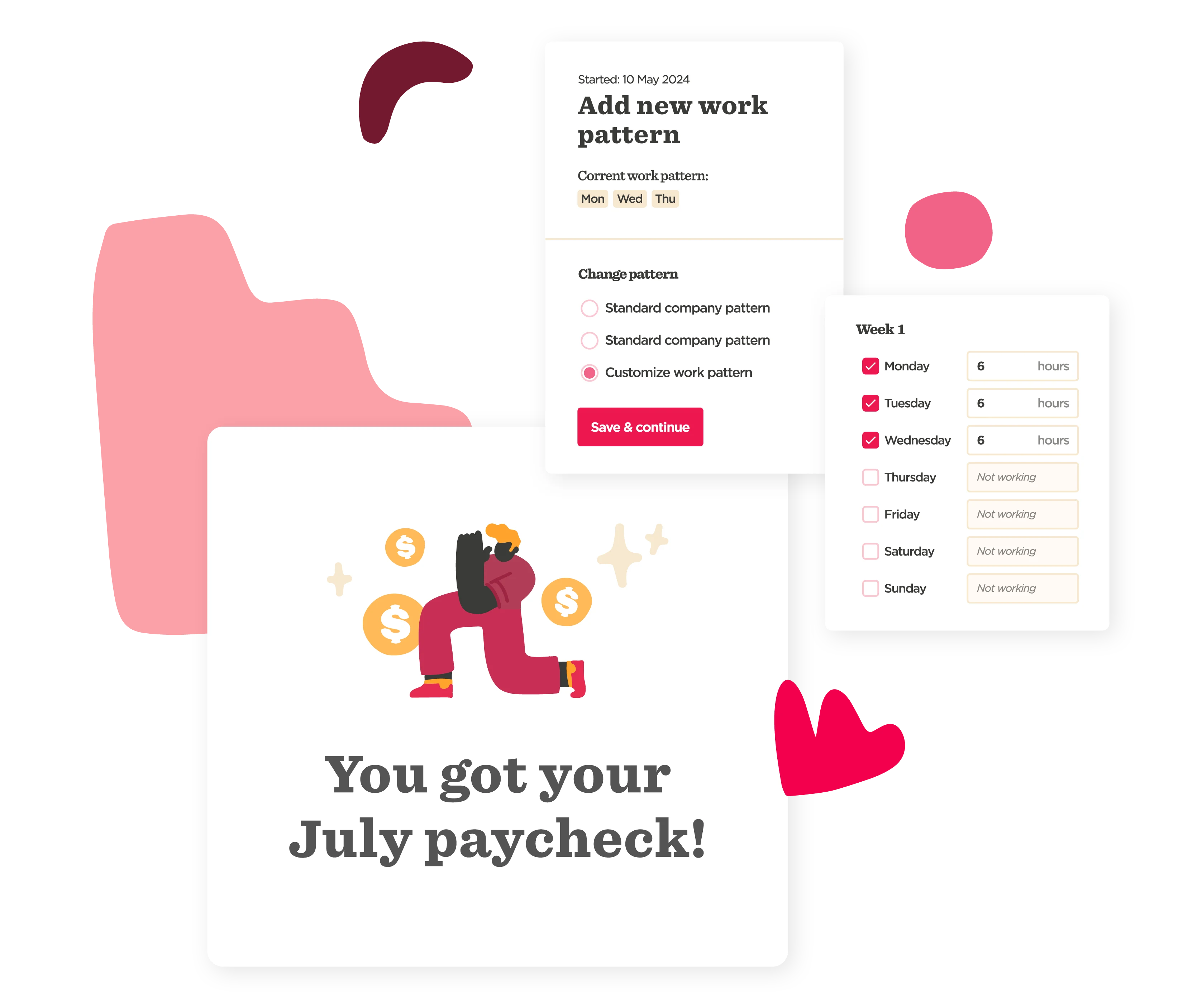It’s essential.
Getting paid for your work makes up the basic transaction that you agree to with your employer: You receive wages in exchange for your time and labor.
While that basic transaction is straightforward, as you may know, traditional payroll processes can be anything but.
From compliance mistakes to endless inefficiencies, traditional payroll comes with significant hidden costs that can have a severe impact on an organization’s HR processes, finances, and reputation.
And its effects can ripple out further than you might expect.
Traditional payroll can come at a significant cost to professionals, too: Close to half of professionals in the United Kingdom have missed a bill payment because of payroll mistakes.
It all boils down to using a payroll solution that adequately meets the needs of organizations and their people—and, as you’ll soon see, with traditional payroll, that can be a struggle.
Let’s take a closer look at payroll problems and solutions. We’ll delve into the hidden costs of traditional payroll, their impact, and what kind of solutions businesses are looking for.
<<Download our payroll solutions comparison template to find the right fit for your business.>>

The time burden of traditional payroll
Traditional payroll can have a significant impact on HR efficiency.
In fact, according to a survey we conducted of 1,000 people across HR, payroll, and finance in the United Kingdom, companies spend an average of five days on payroll every month.
And larger organizations with 200-500 people spend over 10 days a month sorting out manual payroll system problems.
This can be a surprising discovery, especially due to the fact that 73 percent of businesses outsource at least part of their payroll processes.
Even though many organizations rely on an external payroll provider to take care of their payroll processes for greater efficiency, the burden still ends up falling on internal teams. This costs organizations days in productivity and affects the bottom line, with the combined expenses of relying on external vendors and spending internal resources on correcting mistakes.
Some of the repetitive tasks and admin that fall on the shoulders of internal teams include:
- Updating team members’ information
- Ensuring compliance
- Checking for errors
- Correcting payroll discrepancies
All these tasks can drain HR teams of the time they need to carry out their other work, affecting HR processes as a result. In fact, 53 percent of companies report that examining and fixing the most common payroll mistakes takes up the largest amount of time.
This puts added pressure on HR teams and prevents them from carrying out the work they do best: helping the people in their organization thrive.
<<Make compliance a breeze with our payroll compliance checklist. Download now.>>

Inflexibility and its consequences
Ninety-three percent of employers have a payroll submission deadline set by their payroll provider (Pollfish HiBob 2024).
Despite the fact that organizations turn to external payroll providers for greater ease and efficiency, many providers come with difficult processes and strict, inflexible deadlines.
This not only puts more pressure and stress on internal teams, but severely limits organizations, depriving them of the freedom and flexibility to carry out their HR processes the way they need to, reducing productivity and, ultimately, profitability.
The HR process that suffers in particular from the inflexible payroll deadlines is onboarding.
Seventy percent of employers have a deadline to onboard new hires because of payroll—and they’ll often push the onboarding date to the next month as a result (Pollfish HiBob 2024), preventing organizations from addressing their talent shortages when they need to.
Payroll should help organizations thrive rather than limiting their capabilities and stopping them from fulfilling their business needs.
Hidden fees
The errors and inflexible deadlines that come with traditional payroll don’t just take away time and productivity from internal teams, but can also bring significant financial costs.
Problems with payroll like an extra zero, a bank account change, or a tax code that requires updating can increase a company’s expenses.
Correcting any of these errors after payroll deadlines comes with hidden fees that stack up, placing a financial burden on organizations along with the added stress and pressure that internal teams have to bear.
Sixty-five percent of employers have to pay around £5 for every change after the payroll deadline. And 40 percent have to pay more than £10 per change per pay cycle (Pollfish HiBob 2024).
These are costs that can quickly spiral out of control in larger organizations with hundreds of professionals—with more team members there’s a greater likelihood of manual payroll discrepancy.
The worst part is that companies even have to pay to correct errors committed by the payroll provider too, if internal teams spot these mistakes after the payroll provider’s deadline.
This financial risk can add even more pressure on team members that have to help with managing payroll each month.
What’s more, the financial risk can also come in the form of penalties.
One of the main challenges of traditional payroll processing is that it requires manual intervention to correct any errors and compliance issues.
These kinds of mistakes can put companies in hot water with His Majesty’s Revenue & Customs (HMRC) in the United Kingdom, and the American Internal Revenue Service (IRS), leading to large penalties as a consequence.
These mistakes are common, too, with a staggering 88 percent of companies in the United Kingdom receiving HMRC penalties—some as high as £5 million—because of common payroll errors. The IRS also collected close to $7 billion in penalties from American businesses in 2023.
The financial costs of traditional payroll certainly mount up.

Impact on trust and business reputation
The costs of traditional payroll don’t just affect organizations but end up having an impact on their workforces, too.
Forty-six percent of professionals in the UK have missed a bill payment because of a payroll error (Pollfish HiBob 2024).
The financial stress that results from these errors can have a serious effect on the mental wellbeing of your people. And with many struggling to get through the current cost-of-living crisis, this stress can be all the greater.
Organizations that don’t take care of the financial wellbeing of their people by ensuring they receive the right wages, on time, will soon see repercussions on the financial wellbeing of the entire business.
Engagement and productivity will plummet and turnover rates will increase, draining organizations of the talent they need to function—impacting the business’ bottom line as a result.
Consistent payroll errors will erode team members’ trust in their employers and damage the business’ reputation—as well as open the business up to potential lawsuits. The combination of higher turnover rates and a damaged employer brand will make it difficult for organizations to replace the talent they lose so quickly.
Recommended For Further Reading
- Payroll solutions comparison template: Traditional vs. next-gen
- UK payroll compliance checklist: Everything you need to know
- What great payroll looks like in a world where people come first
- 10 best software platforms for streamlining HR and payroll in 2025
- Payroll software features: The essential guide and checklist
- What is payroll in HR systems?
Why businesses are switching payroll providers
It’s clear that because payroll can have such profound effects on an organization and its people, it’s all the more important for organizations to find payroll solutions they can rely on.
But what are businesses looking for exactly when it comes to overcoming their challenges with the payroll process?
Greater efficiency
Traditional payroll is a time-consuming process. External payroll providers don’t always provide the efficiency and ease that organizations need to rely on—since so much of the payroll burden ends up falling on the shoulders of internal teams anyway.
It’s why 57 percent of businesses would switch payroll solutions to improve efficiency (Pollfish HiBob 2024).
A solid payroll solution will be efficient enough to give HR teams the breathing room they need to focus on people strategy, rather than getting bogged down in admin.
Syncing HR and payroll data
Forty-nine percent of companies seek to integrate HR and payroll data better (Pollfish HiBob 2024).
It’s because a lack of synchronization between HR and payroll systems causes a lot of the errors in payroll processing.
Automated data synchronization between HR and payroll systems creates a single source of truth that prevents data silos, manual duplication, and human error.
Automation, accuracy, and compliance
When it comes to manual payroll vs. automated payroll, there’s no competition.
Businesses want a payroll solution that’s automated, accurate, and compliant. An ideal payroll platform is in sync with HMRC and smart enough to fix errors, reducing the risk of compliance issues—issues that are all too common with manual payroll processes.
It means that when a team member updates their address, for example, the payroll platform would pick up the change, auto-update their tax code, and auto-calculate their pay according to the new tax code.
It saves time and ensures compliance and accuracy.
If errors do occur, organizations want payroll solutions that alert them to those errors in real-time, as they happen—saving them the mounting costs of making corrections after payroll deadlines.
Organizations also want more control over onboarding and offboarding processes. They want a payroll provider that allows new hires to enter their P45 details during onboarding, so that they’re used automatically for their first payroll.
Offboarding can also be prone to payroll and compliance mistakes. An ideal payroll solution automatically calculates a leaving team member’s holiday pay, sends their final payroll documents to their personal email, and ensures a smooth offboarding process, without any awkward mistakes for HR teams to correct.
Automation will give internal teams the breathing room they need to focus on the work they do best.
Enhanced employee experience
Better payroll ensures a positive employee experience, too.
With traditional payroll, professionals have to use two separate platforms to access all their HR and payroll documents. It also brings team members the added hassle of constantly reaching out to HR to fix logins or help them understand where their payroll data is stored.
Companies want a solution that makes it easy for their people to access the information they need all on one platform. A solution that allows them to understand their pay and pay slips in a clear, digestible way.
Most importantly, a solid payroll provider will reduce payday errors, since these errors are the most detrimental to the employee experience.
By creating a better employee experience around payroll, organizations will ensure that they maintain their people’s trust in them and that they stay for the long run.
Reliability and flexibility
The lack of flexibility in traditional payroll is a strong motivator for businesses to find other providers.
They want a solution that allows them to easily change pay dates according to their business needs, without it affecting their internal payroll processes.
And they want a provider that offers consistent and reliable support when they need it, so that when issues do arise they’ll be able to work together to solve them rather than just being penalized for them.

A smarter payroll future
Traditional payroll systems are becoming increasingly inadequate at meeting the needs of modern businesses.
The time burden, inflexibility, hidden fees, and potential for errors make them more of a liability than an asset.
But businesses will be able to overcome their payroll and compliance challenges by switching to a payroll provider that offers automation, integration with an HRIS, a positive employee experience, and reliable support.
With smarter payroll solutions, organizations can save themselves a lot of time—and headaches—toward the end of each month, ease the burden on internal teams, and maintain the trust of their people.
